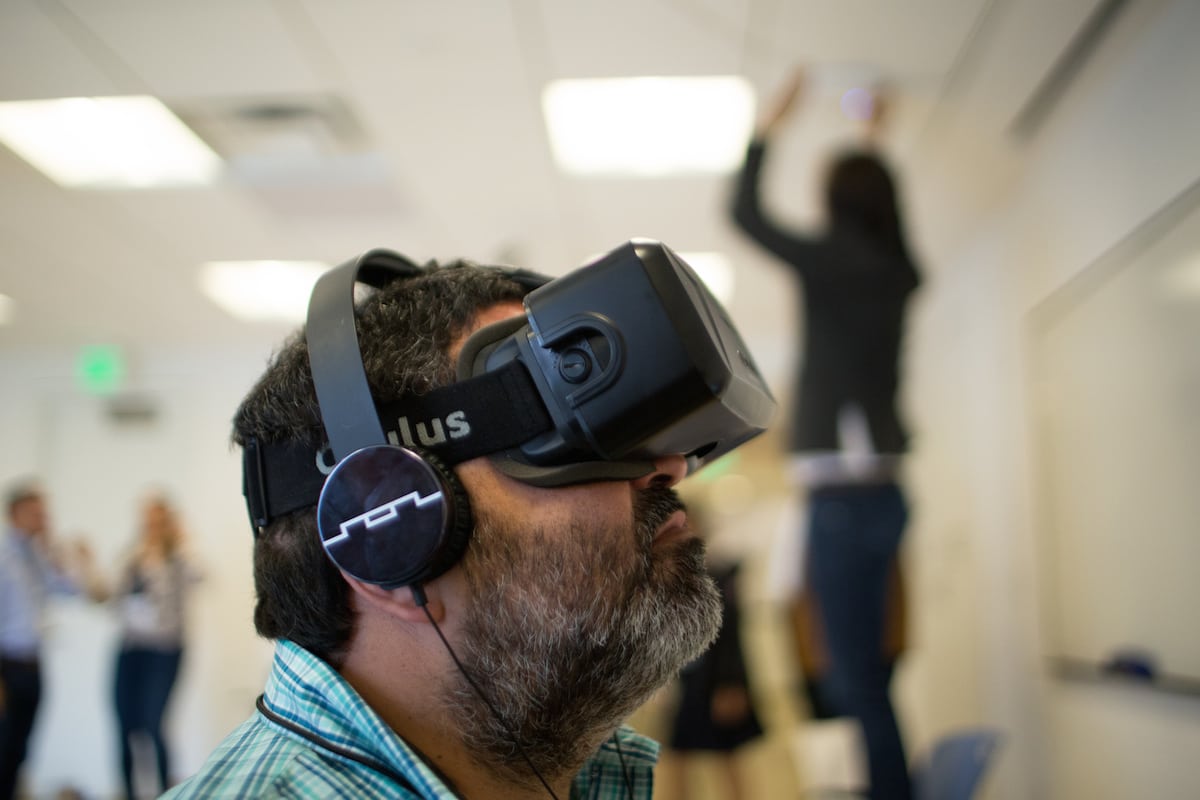
It’s fast becoming a cliché to say that virtual reality is now a reality, but it’s a phrase that really does sum up the current situation. Although we may still be teetering on the edge of an emerging industry, VR headsets have shown us what’s capable in the current climate.
Essentially, we’re in the midst of an entertainment revolution and it’s a revolution that’s spawned an industry many believe could be worth $150 billion by 2020. According to Kieran Kent, managing director of London-based Propeller PR, the combination of augmented reality (technology that layers digital content over physical objects) and VR will transform the world around us.
Thanks to headsets like Oculus Rift, HTC Vive and Samsung VR, the virtual world is becoming more interactive, more powerful and, therefore, more lucrative. As we’ll go on to show, Kent University is now tapping into this emerging market through a combination of research and expos, but it’s undeniable that the main driver for VR at the moment is gaming.
Beyond the current crop of computer games available for Oculus Rift et al, developers in other parts of the gaming world are starting to broach the VR realm. Leading the way in recent months with a VR roulette product is Microgaming. Showcased at ICE Totally Gaming 2016, the award-winning product uses the power of Oculus Rift and Leap Motion 3D controllers to plunge players into a virtual world of roulette.
As it stands, the iGaming industry is a $41 billion enterprise, and roulette is a major part of that industry. Indeed, a look through the gaming lobbies of any leading online casino not only highlights the popularity of roulette, but the evolution of the game inside the virtual arena. As a starting point, online roulette began life as a virtual affair with animated games being controlled by a random number generator (RND). However, as the industry has evolved, modern technology has made it possible for players to interact with real dealers inside the many of the forward-thinking platforms.
“roulette” (CC BY 2.0) by jimshep
For example, when you scroll through 32Red’s selection of roulette games, you’ll see the virtual tables give way to games such as Immersive Roulette. Harnessing the power of RFID chips, webcams and highly trained dealers, these tables don’t simply connect players with a real game, but they offer an authentic online roulette experience.
Naturally, the advent of live dealer technology hasn’t caused the demise of virtual roulette. Indeed, at Foxy Casino you can play traditional European roulette with a single zero in a virtual setting, while Vera John Casino offers players an animated platform to enjoy Key Bet Roulette (a game containing a jackpot “key bet”). In fact, thanks to the growing popularity of live dealer roulette, the virtual game with its myriad of features has become more popular than ever.
However, as popular as virtual games are, it’s the live camera action at casinos like 32Red that’s really caught the playing public’s imagination. Thanks to a system that allows players to chat with the dealers, players are more engaged and, therefore, more entertained. With this in mind, it’s easy to see that players want more realism and that’s where Microgaming’s VR Roulette fits into the equation. Hailed as the next step on the industry’s evolutionary ladder, VR Roulette will essentially fuse the best parts of the current technology and make it a truly immersive experience.
“MIC – Imagin@rium VIRTUAL REALITY” (CC BY 2.0) by pallina60 Loon
Of course, the iGaming industry isn’t the only industry currently harnessing the power of VR to create an immersive gaming environment. Indeed, London’s Inition is a leading VR developer and is currently creating games and VR technology to engage our senses in a multitude of ways.
Using custom technology such as gestural interfaces, tactile feedback devices and full-body interfaces, Inition is creating athletic and logic games that make it look and feel as though you’re really there. In fact, when you look at Inition’s roster of products, you’ll already start to see the evolution of the VR industry.
The development of third-party products such as gesture interfaces will start to make a virtual world even more interactive. At present we’re able to jump into a virtual gaming world and control a character or a roulette wheel as if it was really there. But in the future, we’ll also be able to feel the environments around use, explore different terrains and engage more than just our eyes and ears.
“Virtual Reality Demonstrations” (CC BY 2.0) by UTKnightCenter
How do we know this is the case? Research. Thanks to academics at Kent University, VR is now a science and when any technology is subjected to the rigors of academia it leads to some impressive innovations and, moreover, applications. In fact, as we saw in the recent ICE (Innovation, Creativity and Enterprise) Showcase Event at Kent University, many local and international figures are helping to shape the industry.
From Kent University’s own Dr David Atkins from the School of Engineering and Digital Arts, to Professor Rodric Yates of IBM, the roster of people who picked up awards at the university’s expo are pushing VR into new realms.
Thanks to the combination of academic study at Kent University and the innovations of companies from the surrounding area, the way in which we consume information is changing. Whether it’s the games we play or the way we learn about a new product, the virtual world is becoming more authentic, more immersive and, importantly, more engaging and that’s the reason VR is set to be the next big thing.
Featured image: “Virtual Reality Demonstrations” (CC BY 2.0) by UTKnightCenter